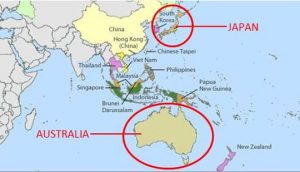The Far East

At a later date I'll include more countries in this section, but for now I'll limit my focus to Japan, China, Australia, and New Zealand.
Japan’s unique and rich history and culture are matched by their amazing cuisine, which has managed to do remarkable things with limited resources. The traditional cuisine of Japan is based on rice and soybeans, in the form of tofu, miso (fermented soy), and edamame (steamed soybeans in the pod). Dishes often consist of fish, pickled vegetables, and vegetables cooked in miso broth. As an island nation, Japan relies on its access to seafood, not just the kinds of fin fish and shellfish with which we’re familiar, but things like sea urchin and abalone. Fish is often served raw as sashimi or sushi (sashimi is slices of uncooked fish; sushi combines fish or egg or even meat with raw vegetables, rolled up with rice and sheets of dried seaweed, and then sliced. Seafood and vegetables may also be deep-fried in a light batter, as tempura. Meat-based dishes started to be seen around the turn of the 20th Century: you’ve no doubt heard about Kobe beef. Something most people don’t know is that in 2011, Japan overtook France to become the country with the most 3-starred Michelin restaurants. As of 2018, the capital, Tokyo, has maintained the title of the city with the most 3-starred restaurants in the world!
China’s cuisine is as varied as its vast geography and climate, with fish dominating the eastern ocean-facing areas, a wheat-based cuisine in the north (think mu shu, a dish in which the mixture of vegetables and meat is eaten by first rolling up in a wheat pancake), and a rice-based cuisine in the south. Unlike the menus we’ve grown accustomed to in Chinese restaurants in the US, meat and fish, where they are consumed, are consumed in very small amounts. Instead, along with rice or dumplings, tofu, eggs, fungi, and vegetables make up most of the meal. Flavorings even show regional variations: The northern provinces of Szechuan and Hunan are known for their hot, spicy cuisines, whereas the Cantonese cuisine is blander, more like what most Americans consider Chinese food, relying more on the old standbys of soy sauce, sesame, ginger, and garlic for flavoring. And of course, I would be remiss if I forgot to mention that throughout Hong Kong and China, chopsticks are used to eat everything…except soup!
The cultures and cuisines of Australia, as well as New Zealand are a blend of Western culture, derived from British rule, and that of the indigenous population. A more friendly group of people you will never meet, with a very “unique” style of wit! If you don’t like salt, avoid their staple Vegemite,® which may be best described as their answer to peanut butter in the US and marmite in the UK. The cuisine in the 21st century reflects the influence of globalization, with many fast-food restaurants and international trends becoming influential. Australia, for example, has become famous for the high quality of its exports, with major agricultural industries including cattle and calves, fruits and nuts, vegetables, milk, sheep and lambs (for both meat and wool), poultry, barley, and canola. It’s also well regarded for its local wines, beers, and soft drinks. Oh, and Australia long ago discontinued use of the penny (something we in the U.S. should consider).